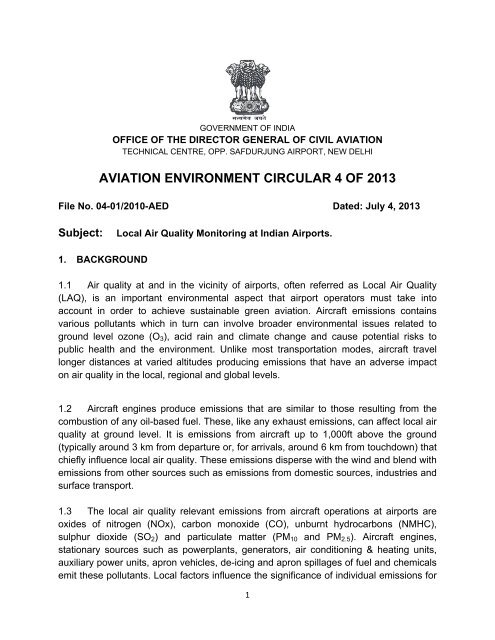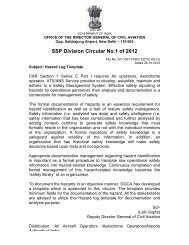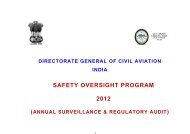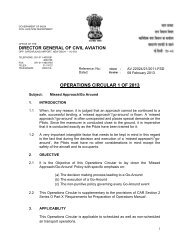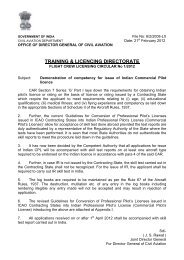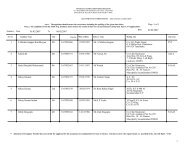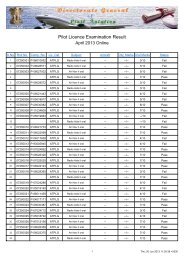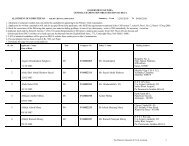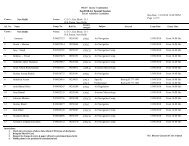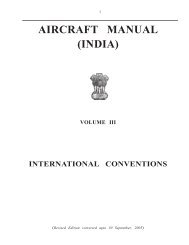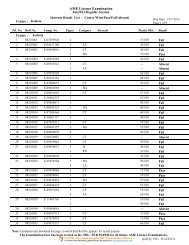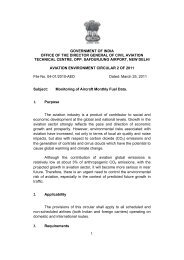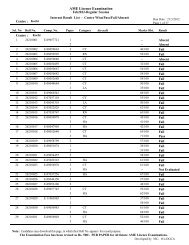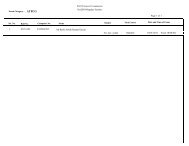Environment Circular 04 of 2013 - Directorate General Civil Aviation
Environment Circular 04 of 2013 - Directorate General Civil Aviation
Environment Circular 04 of 2013 - Directorate General Civil Aviation
Create successful ePaper yourself
Turn your PDF publications into a flip-book with our unique Google optimized e-Paper software.
GOVERNMENT OF INDIAOFFICE OF THE DIRECTOR GENERAL OF CIVIL AVIATIONTECHNICAL CENTRE, OPP. SAFDURJUNG AIRPORT, NEW DELHIAVIATION ENVIRONMENT CIRCULAR 4 OF <strong>2013</strong>File No. <strong>04</strong>-01/2010-AED Dated: July 4, <strong>2013</strong>Subject:Local Air Quality Monitoring at Indian Airports.1. BACKGROUND1.1 Air quality at and in the vicinity <strong>of</strong> airports, <strong>of</strong>ten referred as Local Air Quality(LAQ), is an important environmental aspect that airport operators must take intoaccount in order to achieve sustainable green aviation. Aircraft emissions containsvarious pollutants which in turn can involve broader environmental issues related toground level ozone (O 3 ), acid rain and climate change and cause potential risks topublic health and the environment. Unlike most transportation modes, aircraft travellonger distances at varied altitudes producing emissions that have an adverse impacton air quality in the local, regional and global levels.1.2 Aircraft engines produce emissions that are similar to those resulting from thecombustion <strong>of</strong> any oil-based fuel. These, like any exhaust emissions, can affect local airquality at ground level. It is emissions from aircraft up to 1,000ft above the ground(typically around 3 km from departure or, for arrivals, around 6 km from touchdown) thatchiefly influence local air quality. These emissions disperse with the wind and blend withemissions from other sources such as emissions from domestic sources, industries andsurface transport.1.3 The local air quality relevant emissions from aircraft operations at airports areoxides <strong>of</strong> nitrogen (NOx), carbon monoxide (CO), unburnt hydrocarbons (NMHC),sulphur dioxide (SO 2 ) and particulate matter (PM 10 and PM 2.5 ). Aircraft engines,stationary sources such as powerplants, generators, air conditioning & heating units,auxiliary power units, apron vehicles, de-icing and apron spillages <strong>of</strong> fuel and chemicalsemit these pollutants. Local factors influence the significance <strong>of</strong> individual emissions for1
each airport, but <strong>of</strong>ten NOx is by far the most abundant and is considered the mostsignificant pollutant from a local air quality view point.1.4 The significance <strong>of</strong> aviation's impact on local air quality will vary depending onmany other factors such as, background pollution levels, other sources <strong>of</strong> pollution,weather and proximity <strong>of</strong> residential areas.1.5 Notably, significant improvements have been made over the past two decadesregarding aircraft fuel efficiency and other technical improvements to reduce emissions.However, these advances may be <strong>of</strong>fset in the future by the forecast growth <strong>of</strong> airportoperations and other aviation activities. Hence this issue needs to be addressed in anobjective manner.1.6 ICAO has also recognized that airport-related sources <strong>of</strong> emissions have theability to emit pollutants leading to degradation <strong>of</strong> air quality in the local community. Assuch, national and international air quality programmes and standards require airportauthorities and government bodies to address air quality issues in the vicinity <strong>of</strong> airports.1.7 ICAO has been involved with airport-related emissions for many years. Inparticular, the ICAO Committee on <strong>Aviation</strong> <strong>Environment</strong>al Protection (CAEP) continuesto address the issue <strong>of</strong> emissions standards for new engine types, their derivatives andnew production engines. One <strong>of</strong> the principal results arising from their work is the ICAOSARPS on engine emissions in Annex 16 Volume II. Among other issues, theseprovisions address liquid fuel venting, smoke and the following main gaseous exhaustemissions from jet engines: hydrocarbons, nitrogen oxides and carbon monoxide.Specifically, they set limits on the amounts <strong>of</strong> smoke and gaseous emissions <strong>of</strong> thesethree pollutants in the exhaust <strong>of</strong> most civil aircraft engine types.2. DEFINITIONSCarbon dioxide (CO 2 ) - A naturally occurring gas that is also a by-product <strong>of</strong> burningfossil fuels and biomass, land-use changes and other industrial processes. Carbondioxide is the reference gas against which the global warming potential <strong>of</strong> othergreenhouse gases is measured.Carbon monoxide (CO) - A colourless, odourless gas formed during incompletecombustion <strong>of</strong> fuels. It acts as a respiratory poison in humans and warm-bloodedanimals. It plays a role in the formation <strong>of</strong> ozone in the free troposphere.2
Hydrocarbons (HCs) – Hydrocarbons are compounds containing both hydrogen andcarbon atoms and are divided into methane (CH4) and non-methane hydrocarbons(NHMCs) which are emitted by both natural and anthropogenic sources. Hydrocarbonsare also important with respect to local air quality since they combine in the atmospherewith oxides <strong>of</strong> nitrogen (NOx) to form ozone in the presence <strong>of</strong> sunlight. Hydrocarbonsplay an important role in atmospheric chemistry and also contribute to the destruction <strong>of</strong>stratospheric ozone and global warming.Nitrogen oxides (NOx/NO 2 ) - Nitrogen oxides are a generic term encompassingnitrogen dioxide (NO 2 ) and nitrogen monoxide (NO). Because NO rapidly oxidizes toNO 2 , the emissions are expressed in terms <strong>of</strong> NO 2 equivalents. Nitrogen oxides areformed from the oxidation <strong>of</strong> atmospheric nitrogen at a very high temperature found inthe combustion.Ozone (O 3 ) - Ozone is a colourless gas composed <strong>of</strong> three oxygen atoms. Ozone isgenerated from chemical reactions between nitrogen oxides and volatile organiccompounds in the presence <strong>of</strong> sunlight in the troposphere (ozone also exists in thestratosphere where it is beneficial since it helps absorb harmful ultraviolet solar radiationbefore it reaches the Earth's surface).Particulate matter (PM) - Particulate matter is the term used to describe both coarseparticles with an aerodynamic diameter <strong>of</strong> 10 micrometers or less (PM 10 ) and fineparticles with an aerodynamic diameter <strong>of</strong> 2.5 micrometers or less (PM 2.5 ). Particulatesare the result <strong>of</strong> incomplete combustion. It is formed during industrial productionprocesses, combustion processes, mechanical processes (abrasion <strong>of</strong> surface materialsand generation <strong>of</strong> fugitive dust) and as a secondary formation (from SO 2 , NOx, NH 3 andVOC).Sulphur dioxide (SO 2 ) - Sulphur dioxide is primarily produced from anthropogenicsources. It is formed during the combustion <strong>of</strong> fuels containing sulphur, including coal,oil and gas. Reduction <strong>of</strong> the sulphur content <strong>of</strong> fuels has helped reduce concentrations<strong>of</strong> this pollutant.3. PURPOSEThe objective <strong>of</strong> this circular is to assist airport operators establish their own air qualitymonitoring station and to monitor air quality in the vicinity <strong>of</strong> the airport. The circular hasbeen developed in accordance with ICAO Doc 9889 (Airport Air Quality Manual).3
4. APPLICABILITY4.1 The provisions <strong>of</strong> this circular shall be applicable to all international and domesticairports including private airports, civil enclaves andairports under the jurisdiction <strong>of</strong> theAirport Authority <strong>of</strong>India where the number <strong>of</strong> traffic movements is greater than 50,000per annum (where a movement is a take-<strong>of</strong>f or a landing).5. GUIDELINES5.1 Airport operators mayinstall atleast one continuous monitoring station inaccordance with the measurement methodologies listed in Annexure I.5.2 Itis recommended that airports that do not have a local air quality monitoringstation may install a mobile station that can be used both inside and outside the airportas per the locations (both upwind and downwindd locations)mentionedin ICAO Doc9889 and in accordance with the international best practices.5.3 Inaddition to monitoring pollutants, the station shall also be capable <strong>of</strong>monitoring basic meteorologiical parameters including temperature, wind speed, winddirectionand relative humidity.6. SUBMISSION OF DATA6.1 Airport operators shalll monitor air quality data at their airport(s) for pollutantsindicatedd in Annexure I.6.2 Airport operators shall submit the air quality data to the DGCA on both aquarterlyand an annual basiss as per the formats given in Annexure II.6.3 The above mentionedrequirements are in addition to the requirements laid downby otheragencies, such as State Pollution Control Boards, and do not annul any otherairport-related requirement regarding air pollution monitoring and reporting.(Arun Mishra)Director <strong>General</strong> <strong>of</strong> <strong>Civil</strong> <strong>Aviation</strong>4
Annexure INo. Pollutant Method(s) <strong>of</strong> Measurement1. Carbon monoxide (CO)mg/m 32. Sulphur dioxide (SO 2 )μg/m 33. Nitrogen dioxide (NO 2 )μg/m 3Non Dispersive Infrared SpectroscopyImproved West & Gaeke, UltravioletFluorescenceModified Jacob & Hochheiser (Na-Arsenite),Chemiluminescence4. Ozone (O 3 ) μg/m 3 UV Photometric, Chemiluminescence,Chemical Method.5. Particulate Matter (PM 10 )μg/m 36. Particulate Matter (PM 2.5 )μg/m 3Gravimetric, TOEM, Beta AttenuationGravimetric, TOEM, Beta Attenuation7. Hydrocarbons (HCs) Flame ionization detection method (FID)5
Table 1: Monthly Mean Values (to be submitted every 3 months)Annexure IIAirport:Station Location:Reporting Period: DD/MM/YYYY – DD/MM/YYYYPollutants NO NO 2 NO x CO O 3 SO 2 PM 10 PM 2.5 HCs Temp RH% WS WD*MonthMonthMonth* The prevailing (i.e. most common) wind direction should be reported.6
Table 2: Annual Mean Values (to be submitted every 12 months)Airport:Station Location:Reporting Period: DD/MM/YYYY – DD/MM/YYYYPollutant Minimum** Mean** Maximum** Data Capture % ***NONO 2NO xCOO 3SO 2PM 10PM 2.5HCsTempRH%WSWD** The prevailing (i.e. most common) wind direction should be reported for the mean while nominimum or maximum value should be reported.** The calculation for Minimum, Mean and Maximum values shall be based on hourly valuesrecorded throughout the entire reporting period.*** Data Capture %: this is calculated by dividing the total number <strong>of</strong> valid measurements (e.g.hourly average values stored by the equipment) by the total possible number <strong>of</strong> validmeasurements (e.g. 8760 hours in one calendar year) and converting the result into apercentage (by multiplying by 100). Note: periods where the equipment is being periodicallyserviced or calibrated are not taken into account. For example, in a 30-day month (e.g. June),670 valid hourly measurements were obtained while the analyzer was calibrated during a 5-hourperiod at the end <strong>of</strong> the month and the analyzer malfunctioned for a total <strong>of</strong> 45 hours. In thiscase, the Data Capture % would be 670 / (670 + 45) = 93.7%.7


